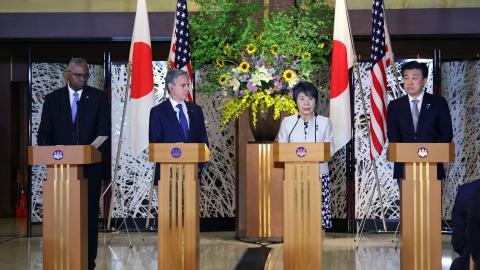Executive Summary
The late Japanese Prime Minister Shinzo Abe first introduced the concept of a free and open Indo-Pacific (FOIP) in July 2016. Over the past eight years, FOIP has redefined the geopolitics of Asia, becoming central to the strategic visions of Japan, the United States, Australia, India, South Korea, key European nations, and the European Union.
Every nation that has adopted FOIP has developed its own version of the concept. But FOIP still repositions the strategic geography of Asia, broadening the region from the Asia-Pacific, which placed a dominant China at the center, to the Pacific and Indian Oceans. This shift highlights the critical role of the four large democracies that comprise the Quadrilateral Security Dialogue (Quad)—Japan, India, the US, and Australia—a partnership the states revived with the ascent of FOIP.
FOIP, moreover, offers a conceptual counter to the strategy of China’s One Belt, One Road (also known as the Belt and Road Initiative, or BRI) by engaging Australia and Europe on the importance of economic development assistance for, and investment in, Southeast Asia.
The Trump administration’s rapid adoption of FOIP—the first time an ally’s strategic concept became central to US grand strategy—deepened America and Japan’s strategic alignment, which encouraged Tokyo to become more engaged in security and encouraged the US to become more engaged in economic development.
The concept has made immense contributions to Indo-Pacific connectivity, prosperity, peace, and security. It has also been central to the Biden administration’s efforts to move away from the traditional hub-and-spoke alliance in which US partners worked directly with Washington as the hub but not with not each other, toward a lattice architecture in which like-minded allies (such as Australia, Japan, South Korea and the Philippines) are linked to each other in a mutually reinforcing effort to meet the region’s security challenges.
However, a Hudson Institute tabletop exercise conducted for this study showed the limitations of FOIP as a strategic doctrine. Specifically, it cannot induce either friendly or less-friendly ASEAN countries to openly aid Taiwan if the People’s Republic of China seeks either to invade or impose a blockade.
FOIP, nonetheless, remains central to promoting prosperity and connectivity in the Indo-Pacific. In the aftermath of Russia’s invasion of Ukraine, Prime Minister Fumio Kishida of Japan refashioned FOIP and focused on promoting agreement around minimal international norms that Russia violated. To enhance regional trust, Kishida highlighted an “Indo-Pacific way,” which would enhance regional resilience by mitigating natural disasters through cooperation under Japanese leadership and enhancing maritime security.
Herein lies the security paradox behind FOIP: The concept can extend the network of partners and allies dedicated to Indo-Pacific security. This, in turn, may reduce the burden America bears by shifting it to other nations. But for the time being, FOIP rests upon the foundation of US deterrence.


















